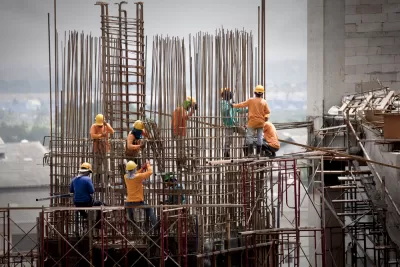An op-ed written by city officials from two South Bay Area cities argues that reform of land use regulations won't be enough to solve California's housing crisis.

Margaret Abe-Koga, Mountain View City Council member, and Rick Bonilla, deputy mayor of the city of San Mateo, write an op-ed for The Mercury News tackling the thorny issue of affordability in California's large coastal cities.
The duo's argument gives consideration to the construction industry, instead of the more typical punching bag of such polemics—land use regulations.
The driving forces behind our housing crisis are not just a shortage of supply, but also a persistent wage stagnation that has priced entire segments of our workforce out of the market. A policy solution must speak to both issues.
Enter the construction industry. Blue collar construction workers have seen a 25 percent decline in their inflation adjusted wages since 1990, according to data from a recent report by Smart Cities Prevail. Meanwhile, white collar employees of the same companies are reaping the benefits of soaring housing costs. "Developer fees and builder earnings now constitute a greater share (18 percent) of total project costs than construction wages and benefits (15 percent). Profits have grown 50 percent faster than either materials or labor," according to the article's recounting of the findings of the report.
Abe-Koga and Bonilla cite the report's findings to make the case for state legislation that would require prevailing wages for construction crafts. Streamlining local regulations, as some state legislators are currently suggesting, wouldn't be enough to bridge the gap between low wages and the high cost of living in the state.
FULL STORY: Opinion: Should private developers be required to pay prevailing wage to build housing?

Study: Maui’s Plan to Convert Vacation Rentals to Long-Term Housing Could Cause Nearly $1 Billion Economic Loss
The plan would reduce visitor accommodation by 25,% resulting in 1,900 jobs lost.

North Texas Transit Leaders Tout Benefits of TOD for Growing Region
At a summit focused on transit-oriented development, policymakers discussed how North Texas’ expanded light rail system can serve as a tool for economic growth.

Why Should We Subsidize Public Transportation?
Many public transit agencies face financial stress due to rising costs, declining fare revenue, and declining subsidies. Transit advocates must provide a strong business case for increasing public transit funding.

How to Make US Trains Faster
Changes to boarding platforms and a switch to electric trains could improve U.S. passenger rail service without the added cost of high-speed rail.

Columbia’s Revitalized ‘Loop’ Is a Hub for Local Entrepreneurs
A focus on small businesses is helping a commercial corridor in Columbia, Missouri thrive.

Invasive Insect Threatens Minnesota’s Ash Forests
The Emerald Ash Borer is a rapidly spreading invasive pest threatening Minnesota’s ash trees, and homeowners are encouraged to plant diverse replacement species, avoid moving ash firewood, and monitor for signs of infestation.
Urban Design for Planners 1: Software Tools
This six-course series explores essential urban design concepts using open source software and equips planners with the tools they need to participate fully in the urban design process.
Planning for Universal Design
Learn the tools for implementing Universal Design in planning regulations.
City of Santa Clarita
Ascent Environmental
Institute for Housing and Urban Development Studies (IHS)
City of Grandview
Harvard GSD Executive Education
Toledo-Lucas County Plan Commissions
Salt Lake City
NYU Wagner Graduate School of Public Service





























